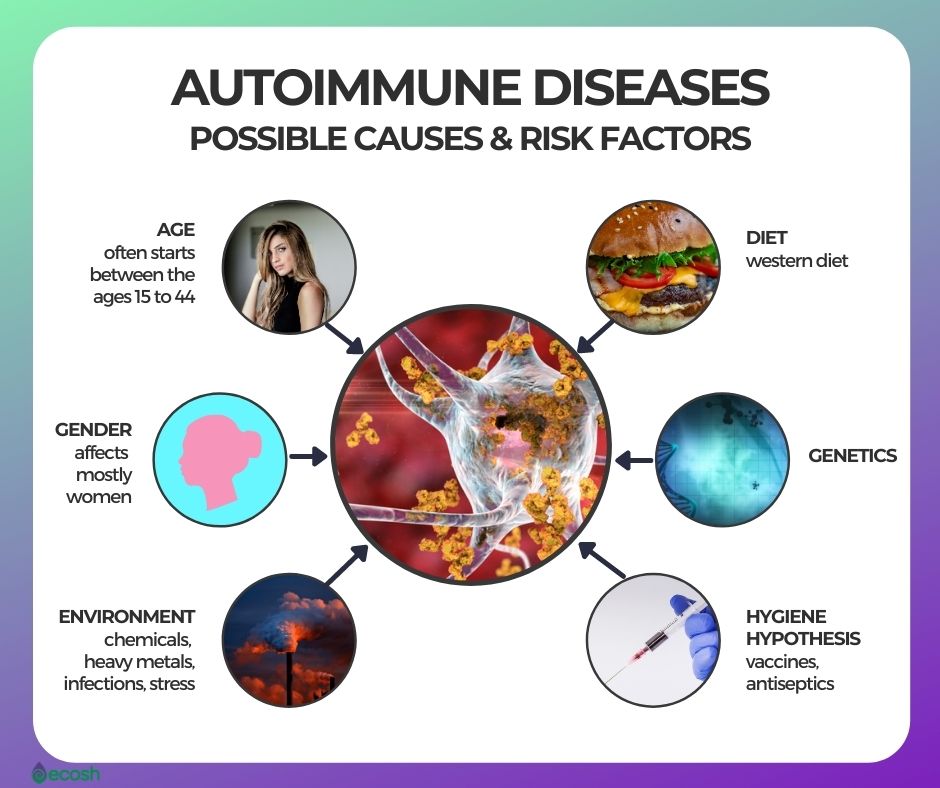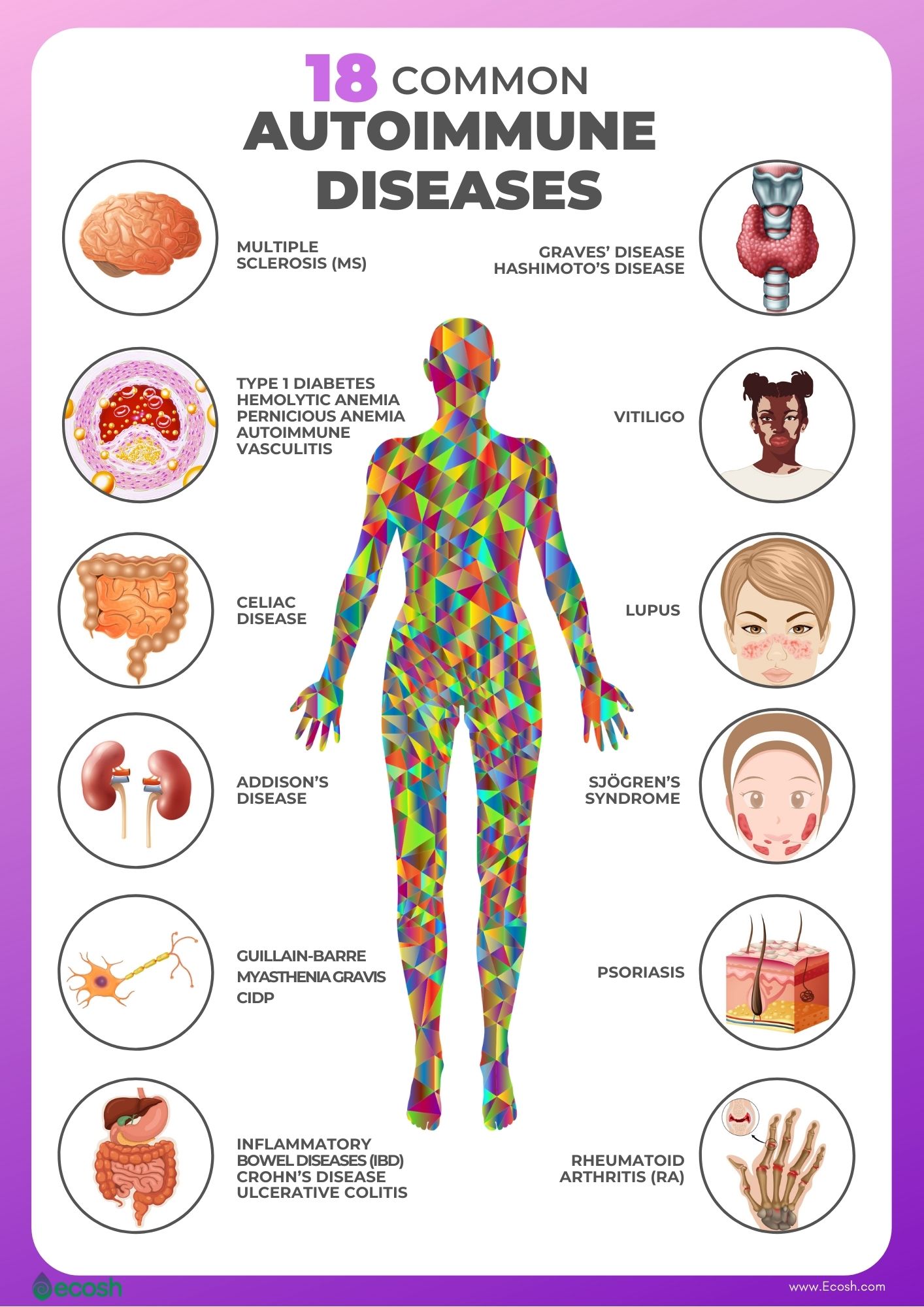Autoimmune diseases are disorders in which the immune system mistakenly attacks your body. Normally, the immune system guards your body against pathogens such as bad bacteria and viruses, and sends out an army of fighter cells to attack these foreign and possibly harmful invaders when it senses these.
The immune system can normally tell the difference between which ones are foreign cells and which ones are your own cells. However, in case of an autoimmune disease, your immune system mistakes some part of your body, like your joints, skin, nerves, thyroid gland, adrenal glands, or blood cells – as foreign. Therefore, it sends autoantibodies (proteins) to attack your own perfectly healthy cells.
Some autoimmune diseases affect only one organ (such as for example type 1 diabetes damages the pancreas), while other disorders (such as for example systemic lupus erythematosus (SLE)), attack the whole body (1).

Autoimmune Diseases Causes, Risk Factors and Risk Groups – Why The Immune System Attacks Your Body?
Researchers still don’t know exactly what causes this kind of immune-system misfire. However, some people might be at higher risk to get an autoimmune disease than others.
- Gender. It is noted that women get autoimmune diseases about two times more often (6.4 % of women vs. 2,7 % of men) than men (1, 25).
- Age. In women, the autoimmune disease often starts between the ages 15 to 44 (1, 25).
- Ethnic group. Some autoimmune disorders are more common in specific ethnic groups. For example, lupus affects more African-American and Hispanic people than Caucasians (1).
- Genetics. Some autoimmune diseases, such as for example multiple sclerosis and also lupus, tend to run in families. It does not mean that every family member will have the same disorder, but they inherit a proneness to an autoimmune disease (1).
- Environment. As the prevalence of autoimmune disorders is rising, researchers think that environmental factors such as exposure to chemicals or solvents and infections might also increase the risk of these disorders (1).
- Diet. Although this has not been proven yet, researchers suspect that a “Western diet” might be another risk factor for developing an autoimmune disorder. This is because highly processed, high-fat, high-sugar foods might be linked with inflammation, which in turn might trigger an immune response (1, 26).
- Hygiene hypothesis. Due to antiseptics and vaccines, children nowadays aren’t exposed to as many germs as they were in the past. Therefore, some researchers suspect that lack of exposure to germs could make their immune system prone to overreact to harmless substances (1, 27).

18 Common Autoimmune Diseases
There are more than 100 different autoimmune diseases. Here are 18 of the most common ones (2, 27):
-
Type 1 diabetes. In type 1 diabetes, the immune system antibodies attack and destroy the hormone insulin-producing cells in the pancreas. Without the necessary amount of insulin, glucose builds up in the bloodstream instead of going into the cells. This buildup of glucose in the blood is called hyperglycemia (the technical term for high blood glucose (blood sugar)). High blood sugar may damage blood vessels and organs like heart, kidneys, eyes, and nerves. Individuals with type 1 diabetes need insulin injections to survive (1, 6).
-
Rheumatoid arthritis (RA). Rheumatoid arthritis is a chronic inflammatory autoimmune disease which occurs when your body’s immune system mistakenly sends antibodies to the lining of your joints, and attacks its own healthy body tissue. In some people, this disorder can affect more than just joints and may also damage other body systems, including the eyes, skin, lungs, blood vessels and heart. Rheumatoid arthritis affects the lining of your joints, and causes a painful swelling that can finally lead to bone erosion, joint deformity and physical disabilities (7). Although new types of medicines have improved treatment options dramatically, in addition to medications you may find relief also in dietary changes, home remedies, and certain supplements.
-
Psoriasis and psoriatic arthritis. Psoriasis is a common chronic skin condition that causes raised, red, scaly patches (commonly with silver-white scales of plaque) on the skin and occurs approximately in 2 to 2.6% of the US population. This skin disease accelerates the life cycle of skin cells. It causes skin cells to multiply too quickly and build up rapidly on the surface of the skin. Psoriasis may take shape in various forms, each with its own symptoms and seriousness level. For instance, psoriasis is often considered as only a skin condition, however, it can also cause psoriatic arthritis which affects about 30% of people with psoriasis and causes swelling, stiffness and pain in the joints. Patients with psoriasis often have a liver disease and deficiencies in bile acids, weakened intestinal barrier, or a leaky gut syndrome. Therefore, there can be many different accompanying health conditions. Conventional treatment can be very useful. However, sometimes it’s not the only solution or only gives a non-permanent effect as it does not treat the cause of the disease. Therefore, there are also many natural remedies for your overall health to relieve this disease, and psoriasis diet is one of them (5).
-
Lupus (Systemic Lupus Erythematosus, or SLE). Lupus is considered a chronic disease that causes inflammation of connective tissues. However the causes of lupus are unknown. It can influence any organ in your body including kidneys, joints, lungs, walls of blood vessels, heart, etc. Lupus often mimics the symptoms of some other health conditions, such as tiredness, joint pain, swelling, rash, and fever. The symptoms of lupus may vary from person to person depending on the weakest place of the individual. Some will have more external symptoms, such as rash on the skin, while in others the disease manifests itself internally. About 1.5 million people suffer from some form of Lupus in the United States, including some of the well known artists. The disease is more common in women (90% of lupus patients are women), and especially among young women. Also the risk of illness is higher if the disease has previously occurred in the family (1, 4).
-
Multiple sclerosis (MS), also known as encephalomyelitis disseminata. MS is a potentially disabling, demyelinating disease (demyelinating disorders are conditions that damage myelin, the insulating covers that surrounds nerve cells, in your central nervous system) in which the protective coating of nerve cells in the spinal cord and brain are attacked by the immune system and damaged. This damage to the myelin disrupts the capability of parts of the nervous system to transfer signals between your brain and the rest of your body. MS has a wide range of signs and symptoms, including physical, mental, and sometimes psychiatric problems. Some symptoms may include numbness, muscle weakness, double vision, blindness in one eye, balance issues, and troubles with walking, sensation or coordination. MS takes several forms, which progress at different rates with new symptoms either occurring in isolated attacks (relapsing forms) or building up over time (progressive forms). Between attacks, symptoms may disappear completely. However, persistent neurological issues often remain, especially as the disease progresses. About 50% of MS patients need help walking within 15 years after the disease starts (1, 8, 9).
-
Graves’ disease. Graves’ disease is a disorder that affects about 1 in 200 people, and is the most common cause of overactive thyroid (hyperthyroidism). Meaning, in Graves’ disease, your immune system attacks the thyroid gland in the neck and causes it to produce way more thyroid hormone than your body actually requires. The thyroid is a butterfly-shaped gland that`s located low on the front of the neck below your Adam’s apple. It controls your metabolism with a few specific hormones which are created by the thyroid and tell your body’s cells how much energy to use. Therefore, thyroid hormones affect just about every organ in your body, even the way your heart beats, and too much thyroid hormones may cause symptoms such as a fast heartbeat, nervousness, weight loss and heat intolerance. Without treatment, hyperthyroidism may lead to severe complications with the heart, bones, muscles, menstrual cycle, fertility, and cause health problems for the mother as well as for the baby during pregnancy. Graves’ disease also can affect your eyes (also called Graves’ eye disease, Graves’ ophthalmopathy or Graves’ orbitopathy), which occurs in around 30% of those who have Graves’ disease, or/and skin (Graves’ dermopathy). Graves’ disease is a serious health condition and needs to be treated by your healthcare provider. However, along with conventional treatment you may find help in some vitamins, lifestyle changes, home remedies, and changes in diet (10, 11).
-
Hashimoto’s thyroiditis, also called Hashimoto’s disease. Hashimoto’s thyroiditis is a disease in which the immune system attacks your thyroid, and causes the production of thyroid hormone to slow down to a deficiency. Inflammation from Hashimoto’s disease (chronic lymphocytic thyroiditis), frequently leads to an underactive thyroid. Therefore, Hashimoto’s disease is the most common cause of hypothyroidism (underactive thyroid). Symptoms of Hashimoto’s disease mostly include fatigue, swelling of the thyroid (goiter), weight gain, hair loss and sensitivity to cold. It typically affects middle-aged women but can also happen in children, and in men and women of any age. Treatment for Hashimoto’s disease with thyroid hormone replacement is usually simple and effective. In addition, you may find some help in alternative medicine, Hashimoto’s diet and certain supplements (1, 12).
-
Inflammatory bowel disease. Inflammatory bowel disease (IBD) is a term for two health conditions that cause inflammation in the lining of the intestinal wall. This prolonged and continuous inflammation leads to gastrointestinal tract damage. Each type of IBD affects a different part of the GI tract:
- Ulcerative colitis. Affects the lining of the large intestine (colon) and the rectum.
- Crohn’s disease. Can inflame any part of the GI tract (from the mouth to the anus). Most often it affects the portion of the small intestine before the large intestine/colon (13).
-
Addison’s disease, also called adrenal insufficiency. Addison’s disease is an uncommon condition that affects the adrenal glands (located just above the kidneys), which produce the hormones cortisol and aldosterone as well as androgen hormones. Therefore, in Addison’s disease when adrenal glands are affected – your body doesn’t make enough of these hormones such as cortisol and, often, also aldosterone anymore. Deficiency of cortisol can influence the way the body uses and stores carbohydrates and sugar (glucose). Having too little of aldosterone will cause sodium loss and excess potassium in the bloodstream. Symptoms of Addison’s disease include low blood sugar, weakness, fatigue, and weight loss (1, 14).
-
Sjögren’s syndrome (SjS, SS). This is a long-term autoimmune disease that influences the body’s moisture-producing (lacrimal and salivary) glands. These glands provide lubrication to the eyes and mouth. Sjögren’s syndrome also often severly affects other organs systems, such as the kidneys, lungs and nervous system. Main symptoms are dry eyes and mouth, fatigue and pain. Characteristic symptoms of Sjögren’s syndrome include dry eyes and dry mouth, but it may also affect the skin and joints (15).
-
Myasthenia gravis (MG). Myasthenia gravis is a long-term neuromuscular autoimmune disease that affects nerve impulses that help the brain control the muscles, and causes varying degrees of skeletal muscle weakness that gets worse with activity and improves with rest. The most commonly affected muscles are those that control facial movements, eye movements, eyelid opening, and swallowing. It can result in drooping eyelids, double vision, trouble talking, and problems with walking (16).
-
Autoimmune vasculitis, also called Vasculitis. In vasculitis the immune system attacks blood vessels causing inflammation and narrowing of blood vessels (arteries, veins and capillaries), therefore, allowing less blood to flow through them. As these vessels carry blood to and from the heart and the body’s organs, severe narrowing of blood vessels can lead to organ damage or death. This disorder can influence any organ, so symptoms vary widely and can happen almost anywhere in the body (3, 17).
-
Pernicious anemia. This is a disorder in which the body cannot make enough healthy red blood cells because it doesn’t have enough vitamin B12 (naturally found in animal products, including fish, meat, poultry, eggs, milk, and milk products). Pernicious anemia causes deficiency of a protein, produced by stomach lining cells, known as intrinsic factor that is needed in order for the small intestine to absorb vitamin B-12 from food. Inadequate amounts of vitamin B12 will lead to anemia, and the body’s ability for proper DNA synthesis will be altered. Your body also needs vitamin B12 to make healthy red blood cells and to keep its nervous system function properly. Pernicious anemia affects 0.1 % of people in general, but almost 2 % of people over age 60, therefore, this condition is more common in older adults (3, 18, 19).
-
Celiac disease. Individuals with celiac disease can’t eat gluten (a protein found in wheat, rye, barley and other grain products). Because, if they do so, and the gluten is in the small intestine, the immune system responds by attacking the small intestine, and causes inflammation and damage to this part of the gastrointestinal tract. Celiac disease affects only about 1% of people in the United States. Therefore, any gluten intolerance does not mean you have Celiac disease. Celiac disease can cause symptoms such as fatigue, weight loss, diarrhea, bloating and gas, abdominal pain, nausea and vomiting, and constipation (1, 20, 21, 22).
-
Guillain-Barre syndrome. Guillain-Barre syndrome is a rare condition in which your body’s immune system attacks your nerves controlling muscles in the legs and sometimes the arms and upper body. Usually the first symptoms are weakness (which can sometimes be severe) and tingling in your extremities. These sensations may rapidly spread, and finally paralyze your whole body. Symptoms include also rapid heart rate, and difficulties with facial movements, bladder control or bowel function, breathing and walking. Filtering the blood with a procedure called plasmapheresis is the main treatment for Guillain-Barre syndrome (3, 23).
-
Chronic inflammatory demyelinating polyneuropathy (CIDP). CIDP is a neurological disorder in which similarly to Guillain-Barre syndrome, the immune system attacks your body’s nerves. But in case CIDP, symptoms last much longer. Depending on a person, symptoms may differ, but usually include tiredness and areas of pain and numbness. This disorder can slow your reflexes and make your arms and legs feel weak. If not diagnosed and treated early enough, around 30% of patients can become confined to a wheelchair. Treatment for CIDP and GBS are essentially the same (3).
-
Vitiligo. Generally, Vitiligo is also considered to be an autoimmune disease in which the immune system appears to attack the pigment cells (melanocytes) in the skin, and causes the skin to lose its pigment cells (melanocytes). This results in discolored patches in different areas of the body, including the skin, hair and mucous membranes (24).
-
Hemolytic anemia. Hemolytic anemia happens when the immune system demolishes your red blood cells. This destruction leads to an oxygen deficiency, which causes symptoms such as shortness of breath, dizziness, headache, cold hands or feet, fatigue, yellow whites of the eyes or skin, and cardiovascular problems, including heart failure (27).
NB! The information provided here is for informational purposes only. So do not consider it as health care or medical diagnosis and treatment. Do not consider this information as a guarantee of the results you want to achieve. In addition, this information is not intended to replace the advice of your physician or other healthcare professional.
Even more, you should not use it to diagnose or treat a health problem. Before changing or discontinuing your existing medication, treatment, or care, or taking any dietary supplements, be sure to consult with your healthcare professional or doctor before starting any diet or program, or if you suspect you may have a medical condition.
Compiled by Maria-Helena Loik
Pictures: Pixabay.com, Pexels.com, Shutterstock.com
Sources:
- Autoimmune Diseases: Types, Symptoms, Causes, Diagnosis & More (healthline.com)
- Autoimmunity and the Gut (hindawi.com)
- Autoimmune Diseases: What Are They? Who Gets Them? (webmd.com)
- Statistics, Facts and Figures of Lupus (verywellhealth.com)
- Is psoriasis a bowel disease? Successful treatment with bile acids and bioflavonoids suggests it is – PubMed (nih.gov)
- Hyperglycemia (High Blood Glucose) | ADA (diabetes.org)
- Rheumatoid arthritis – Symptoms and causes – Mayo Clinic
- Multiple sclerosis – Wikipedia
- Multiple Sclerosis Review (nih.gov)
- Graves’ ophthalmopathy. (nih.gov)
- Graves’ Disease | NIDDK (nih.gov)
- Hashimoto’s disease – Symptoms and causes – Mayo Clinic
- CDC -What is inflammatory bowel disease (IBD)? – Inflammatory Bowel Disease – Division of Population Health
- Addison’s disease – Symptoms and causes – Mayo Clinic
- Sjögren syndrome – Wikipedia
- Myasthenia gravis – Wikipedia
- Vasculitis (arthritis.org)
- Pernicious Anemia | NHLBI, NIH
- Optimal management of pernicious anemia | JBM (dovepress.com)
- Gluten Intolerance | Celiac Disease – MedlinePlus
- Celiac disease and non-celiac gluten sensitivity | The BMJ
- Celiac disease – Symptoms and causes – Mayo Clinic
- Guillain-Barre syndrome – Symptoms and causes – Mayo Clinic
- Vitiligo: MedlinePlus Genetics
- Updated assessment of the prevalence, spectrum and case definition of autoimmune disease – ScienceDirect
- Role of “Western Diet” in Inflammatory Autoimmune Diseases | SpringerLink
- List of autoimmune diseases, with symptoms and treatments (medicalnewstoday.com)


